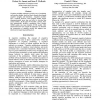Free Online Productivity Tools
i2Speak
i2Symbol
i2OCR
iTex2Img
iWeb2Print
iWeb2Shot
i2Type
iPdf2Split
iPdf2Merge
i2Bopomofo
i2Arabic
i2Style
i2Image
i2PDF
iLatex2Rtf
Sci2ools
AAAI
2006
2006
AI Support for Building Cognitive Models
Cognitive modeling techniques provide a way of evaluating user interface designs, based on what is known about human cognitive strengths and limitations. Cognitive modelers face a tradeoff, however: more detailed models require disproportionately more time and effort to develop than coarser models. In this paper we describe a system, G2A, omatically produces translations from abstract GOMS models into more detailed ACT-R models. G2A demonstrates how even simple AI techniques can facilitate the construction of cognitive models and suggests new directions for improving modeling tools.
AAAI 2006 | Cognitive Modeling Techniques | Cognitive Models | Human Cognitive Strengths | Intelligent Agents |
| Added | 30 Oct 2010 |
| Updated | 30 Oct 2010 |
| Type | Conference |
| Year | 2006 |
| Where | AAAI |
| Authors | Robert St. Amant, Sean P. McBride, Frank E. Ritter |
Comments (0)

